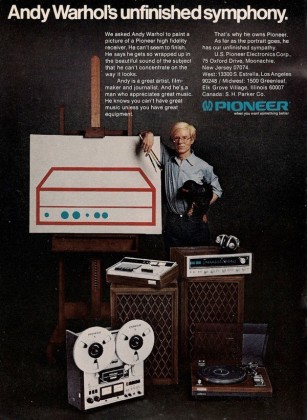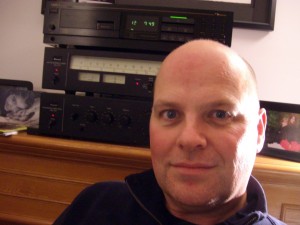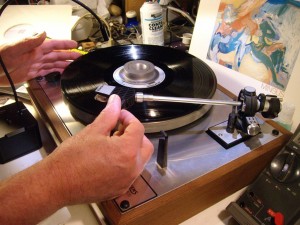One turntable and no microphone – bliss for true audiophiles
 Once upon a time, certain magazines were chock full of ads for very expensive stereo equipment. Since men were typically the buyers of such gear, they appeared in publications like Playboy, Popular Science, or National Lampoon.
Once upon a time, certain magazines were chock full of ads for very expensive stereo equipment. Since men were typically the buyers of such gear, they appeared in publications like Playboy, Popular Science, or National Lampoon.
Sometimes the ads featured a celebrity. Others were like liquor ads, which also filled the pages of men’s mags, where a mustachioed man stood in his sports coat next to his blonde wife, tumbler of scotch in hand, explaining why only the Pioneer B-747 FBI WD-40 tuner/amplifier could perform to his high standards.
Sonic radio morning man Garner Andrews remembers dreaming of owning this sort of top-end equipment. But as a teen in Foam Lake, Sask., all he could afford was a crummy YORX stereo that he bought from the TV repair shop where he worked part-time. Andrews now works in a studio loaded with modern electronics where music is played directly from hard drives, and in fact is of the opinion that digital is superior to vinyl – so why on earth does he have a vintage analogue stereo in his office, and one at home, too?
Andrews says, “It’s fun to come back to the office and flip a few dials.”
There’s just something about the way an old stereo looks, he continues. The controls are round knobs. There’s the glow of an orange light along the rectangular bandwidth display. And his turntable is made of metal and wood instead of black plastic.
“It’s a little steampunk,” he says. “The looks of a piece of equipment are very important to me. I realized that my thing with stereo equipment is no square buttons. Ultimately, my goal is to get the kind of stereo I couldn’t afford when I was in high school.”
Jac Zylstra, who moderates a Google group for vintage stereo enthusiasts in northern Alberta called Black Hat Desperaudios, took up audio gear as a hobby about 15 years ago. Like Andrews (who is a member of the group), he lacked the cash in his early years to buy good stuff, but he figured out a few years back that he could supplement his stereo funds by reconditioning old gear for other enthusiasts. The salvage pile in Zylstra’s basement workshop in southeast Edmonton is a who’s who list of the electronics market in the 1970s. There’s Marantz and Sansui amplifiers, Thorenz and Technics turntables, and Sony and Telefunken tuners. Some of the speakers are the size of small refrigerators.
 Customers tend to be guys who, like him and Andrews, always wanted great gear but couldn’t afford it, or sold it after they got married. But there’s also a second group, Zylstra says, who are young, often in their early 20s.
Customers tend to be guys who, like him and Andrews, always wanted great gear but couldn’t afford it, or sold it after they got married. But there’s also a second group, Zylstra says, who are young, often in their early 20s.
“It’s a little bit hipster. You’ve got guys who come here and they own vinyl but they don’t have anything to play it on. But it’s cool,” Zylstra says about the young crowd. “They have no idea what a pitch control is for or what speed it’s supposed to do. These are kids who’ve grown up with some sort of iPod and downloaded on mp3, which as we know is about 11 per cent (quality) and they play vinyl and hear it, and get into it. They can hold it. It’s an experience.”
Last year, vinyl sales spiked like a VU meter blasting a Led Zeppelin record, with Nielsen Soundscan reporting 3.9 million units sold last year in the U.S. – an increase of 39.3 per cent over 2010. BBC Radio 6 even had an all-vinyl day on Jan.1.
Listening to an iPod isn’t the same. You can do other things and it keeps on playing. An old fashioned stereo requires you to pay more attention to the music. If you don’t, it stops.
“I’d forgotten what it was like to sit in a chair and listen to a record. You can’t go too far. You can’t mow the lawn or paint the fence,” Andrews explains. “It’s an experience. It’s sitting around and staring at an album cover, and cleaning the record.”
The Sonic announcer says he spends his spare time these days looking through antique stores for albums. He’s imposed a collection limit of 200, so he’s sticking to only the records he’s always wanted – artists like The Police, Devo, and The Cars.
 “You feel a bit like a treasure hunter,” Andrews says. “My wife thinks I’m having a midlife crisis.”
“You feel a bit like a treasure hunter,” Andrews says. “My wife thinks I’m having a midlife crisis.”
Analogue was a bit of work. But maybe the suffering makes the songs better.
Andrews has an old mix tape in his office that a friend made for him when he was moving from Saskatoon to Victoria in 1987. He calls it “The Greatest Mix Tape Ever Made” and it has The Strangers, The Fabulous Poodles and The Screaming Blue Messiahs on it. He tried to play it on a cassette deck at Sonic (they still have one in the building) but it sounded like it was about to jam, so he hit stop. The person who made it had to do more than drag files. Someone selected the songs, hit pause on the cassette deck, cued the next track, released the pause button, and then waited for the song to end in order to begin the process again for the next song.
His friend did that for him. How could he throw it away?











